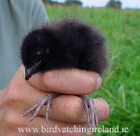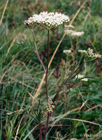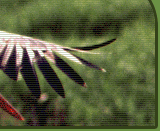The season of mowing the biologically valuable grasslands is open Yesterday, on July 10, the mowing of biologically valuable grasslands has started. So is stated in the agreements with the Rural Support Service for all those landowners who manage the so-called “green meadows”. The season of mowing the biologically valuable grasslands is open Yesterday, on July 10, the mowing of biologically valuable grasslands has started. So is stated in the agreements with the Rural Support Service for all those landowners who manage the so-called “green meadows”. The mowing of biologically valuable grasslands can be continued up to the September 10. It is very important that the grasslands are mowed gradually, and not the whole area at once. One of the main reasons why the biologically valuable grasslands should be mowed at this late time, are the birds nesting on the meadows, especially landrail. They brood twice, and during the second brood in the first part of July nestlings are just hatched and are able to run by themselves. The earlier mowing causes great possibility to destroy the nests. It should be reminded that one fourth of EU’s landrail population nest in Latvia and its protection is very important. The choice of different mowing time is necessary also from the botanical point of view, because many of rare plant species of the “green meadows” bloom and ripen seeds at different times. During the grazing on the green meadows it is very important to consider the cattle density, so that it doesn’t exceed the allowed quantity, and biologically valuable grasslands do not get degraded due to the grazing.  | |  | |   | | It is not allowed to mowe from the sides of the meadow to the centre | | Chicken of Corncrake Crex crex has been saved during the mowing | | There are seeds of Sticky Catchfly at the end of July rippen, but Cnidium dubium has started to florish still | The farmers still complain that the weather conditions this year were very bad for haymaking, and the prolonged July rain also bothered. Differently, on the floodplains the grass keeps mellowness for a longer time, and high-quality fodder can be gathered also during late mowing. The aim for these grasslands definitely is keeping their high biological value, and that’s why the quality of the received hay could objectively be a little worse. However, it is compensated by the European Union’s agricultural environment subsidies provided for keeping biologically valuable grasslands. This year the Ministry of Agriculture decided not to grant the subsidies for this aim to the new areas, under the pretence of Brussels’ yet unadopted Rural Development Programme for 2007-2013. The liabilities taken up in the previous years continue, and it is possible for the farmers to receive 138 euros for keeping a “green meadow” according to the provisions, as well as receive other subsidiary payments in accordance with the provisions. The stress should especially be laid on the territories of Natura 2000, where it is possible to receive the additional support for keeping the green meadows. This year the Latvian Fund for Nature did not announce the application for keeping the possible biologically valuable meadows, because the Ministry of Agriculture did not show yet the interest about the continuation of this project. The landowners regularly call the Fund and still show their interest, however it is clear that there will not be such possibility this year. They still hope that determination of biologically valuable grasslands could continue next season, although it depends on the Ministry of Agriculture. In this case the information will be published in advance on the website of LFN, in biggest daily newspapers, and the consultants of rural parishes will also be informed. Many of landowners called the Latvian Fund for Nature and complained that the grasslands that were determined as biologically valuable last year is not shown in green colour on the maps received this year from the Rural Support Service. The Rural Support Service made a mistake while printing the maps, and for the biggest part of Latvian regions the old maps of rural block were printed – without the newly determined green rural blocks. By this time the Rural Support Service must be already corrected the mistake. The Latvian Fund for Nature invites all the landowners and keepers to continue keeping the biologically valuable grasslands. At least twenty years should pass until the biologically valuable grassland would restore instead of the ploughed green meadow. That’s why also those landowners who couldn’t apply for the receipt of the provided support this year are asked not to plough their areas and not to destroy biologically valuable grasslands, but apply for the receipt of the support for the next year, and mow or pasture the green meadows also in the future. In the gallery of the Latvian Fund for Nature webpage the photographs of indicating species for the natural meadows are available. According to the criteria, the landowners can apprehend whether their meadows are biologically valuable from the botanical point of view.   
| 






